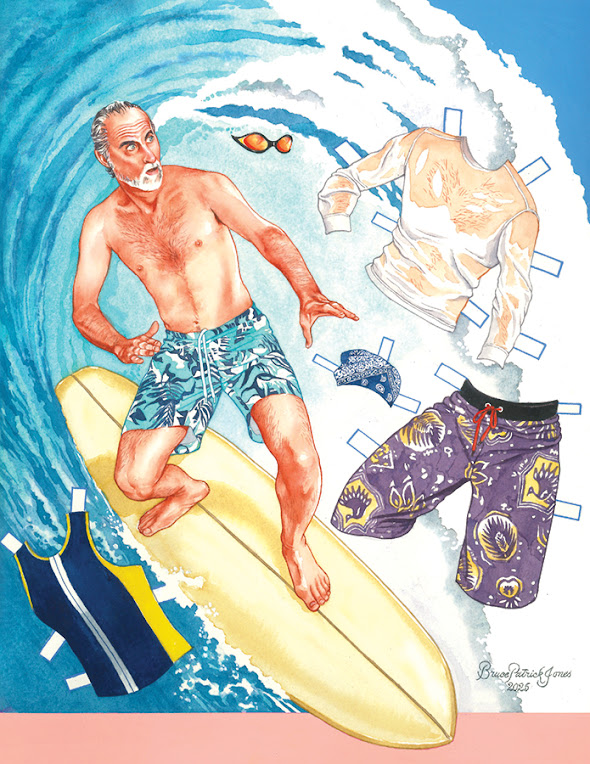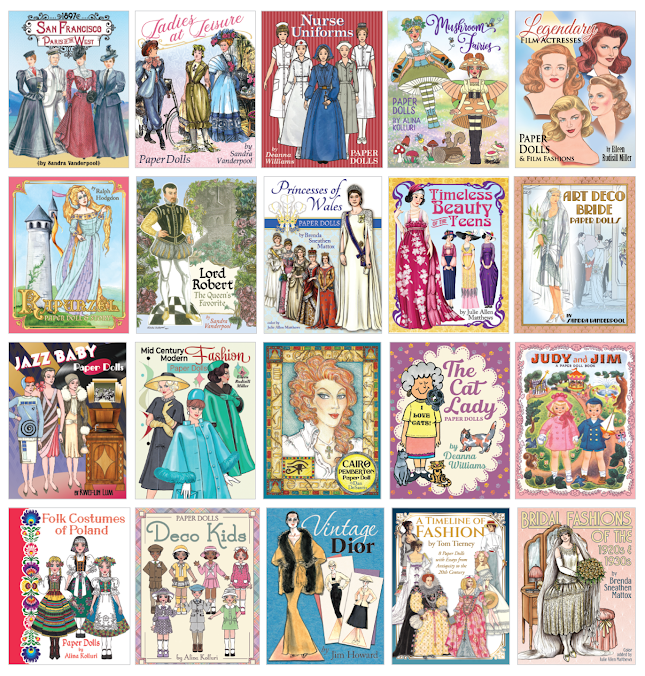Why Paper Dolls?
by Marguerite Carrithers
Article reprint from Paperdoll Review Issue 88 (2023)
Why paper dolls? It feels too big for any one person to sum up in a thousand or so words, topped with some pithy jokes and wrapped up in a page or two. Paper dolls have been around for centuries; the first we’d recognize were made in Europe during the mid 1700s, though it wasn’t until 1810 that the first manufactured paper doll, Little Fanny by S&J Fuller of London, was made. And they certainly aren’t going anywhere any time soon.
Advancements in technology haven’t made them irrelevant; if anything, they’ve made them more accessible than ever before. Even in my own life, paper dolls appeared again and again throughout my memories in a way I hadn’t previously realized. My grandmother introduced me to them, and my earliest attempts at drawing were paper dolls. For a brief strange period in fifth grade, I was even selling them to kids at my school. Paper dolls in all their deceptive simplicity keep showing up in magazines, activity books and online, without ever raising an eyebrow or seeming out of place. So what keeps bringing us back?
Maybe it was just something too large or obvious to be answered. But it was a question I kept coming back to, especially as someone lucky enough to have an internship with Paperdoll Review. So I went about trying to answer it as best I could, which is to say by first asking others. I put out the question to artists and collectors within the paper doll community, including several Facebook groups, and the response I received was both absolutely amazing and somewhat overwhelming. People shared some of their favorite memories of paper dolls, their first experiences, and even some paper dolls that were especially notable for them. The paper doll community is one that is exceptionally welcoming and I am very thankful for that fact. And while I was not able to include all of the responses, each was invaluable. With over a hundred responses, patterns quickly began to emerge. Whether they came into people’s lives as children or later, some qualities ensured that paper dolls remain as relevant as ever.
Accessibility
“They are low-tech,” said paper doll artist David Wolfe. “Just a pair of scissors is all you need … It’s important to note that paper dolls are absolutely affordable.” Many of those who discovered paper dolls in their childhood spoke about their accessibility in comparison to fashion dolls or other toys available. Sheryl Knowles shared that in a childhood where moving was common due to family in the Air Force, paper dolls were ideal for being able to carry many in a shoebox. For others, like fashion designer and FIT professor Renaldo Barnette or artist Gregg Nystrom, paper dolls were easier for a young boy interested in fashion and glamour to get his hands on than something like Barbie. Even outside of paper dolls found in magazines, comics or books, anyone can create their own paper dolls so long as they have paper and a pencil. In this way, they also are limitless in the stories that can be created.
Paper Dolls as Tactile Play
Current research shows that children learn through play, especially. But it’s not just them. Play is how we first make sense of the world around us, building nerve connections and observing cause and effect. It’s how we begin to figure out what we might want our lives to look like and what we think is possible. Play has also been discovered to be useful for adults as well, with it helping maintain problem-solving skills and thinking on your feet. This is even truer when it comes to what is called tactile or sensory play (which might more traditionally just be called play, to further complicate things) where one is physically interacting with an object or the world around them. Don’t get me wrong, as a member of Gen Z I’m grateful that I’ve basically always had modern technology at my disposal but there’s a reason the toy world didn’t go completely virtual like some predicted it might in the ’90s. Physical interaction is how we know we’re connected to the world around us and that we have a place in it. 2020 made this clearer than ever, with people flocking to activities like baking or crafting in the absence of being able to go outside.
Paper dolls are an ideal form of tactile play, combining creativity with a material component. They may be beautiful simply on the page (more on that later), but in use they shine. Teri Pettit points out that “There are other kinds of art toys that were popular in the ’60s and ’70s, like Paint by Number kits, Lite Brite, Spirograph, string art, etc., but for most of them you do the picture creation phase, and then you’re done with it and have to move on. But with paper dolls and paper play scenes, you first create something, and then you have a real toy when you’re done.” Becky Mueller uses paper dolls when tutoring six- year-olds, “They’re a fun way to teach vocabulary like arm, shirt, lace, etc. and the girls get to take the dolls home when they successfully learn to read the words.” Melissa Pepe recalled from her own experience that practicing fine motor skills came easier when her mother gave her paper dolls to cut out.
Paper Dolls as Historical Record
Many paper dolls depict historical periods, with fashion historians like Brenda Sneathen Mattox, Tom Tierney, Norma Lu Meehan, and many others who’ve worked within the paper doll industry. They also function as cultural artifacts of the time they were produced, for better and for worse. They are a portal into the time that created them and sometimes, when created after the fact, a way of acknowledging histories that may not always be as visible. Paper dolls have been tied to everything from celebrities to art movements to the ever-changing world of fashion. “They are iconic in representing styles, culture and fashions from specific decades,” said Jeannine Parent. Unlike a book or documentary, they’re something that can be manipulated and used to let the past and present interact. Any historian will tell you that paper, along with fabric, is the most difficult material to preserve and yet often can yield some of the most information on what culture of the time was like. The work of those who scan and archive paper dolls from the past is incredibly valuable, not only for those who enjoy it now but for those who will one day be studying the world we live in. They also, as pointed out by Marcia Dennis Lickei, can be much more compact to store than vintage textiles.
Paper Dolls as Art Objects
At the end of the day, paper dolls are tiny pieces of art. Even better, they’re art that can be held. Paper doll artist Kwei-lin Lum says “Paper dolls resonate with me as an uncut art form, at their best mysterious arrangements of objects in a two-dimensional space.” Each artist brings their own style to paper dolls, an extension of how they create. Paper dolls can also be easier for artists to mass-produce. I know that I own ones from artists whom I will never be able to afford original work from. “My parents had a book on art history that I perused for hours on end,” says Dawn Kiefer, “ I think the combination of paper dolls and the art history book led to my lifelong interest in art appreciation as well as the evolution of fashion.” For Sylvia Kleindinst, paper dolls led to a career in art education. Whether they’re in a frame, a book, or cut out ready to tell whatever story you can imagine, the same thing which draws us to all forms of art draws us to paper dolls. Humans have the ability to seek out beauty. In some ways it makes us what we are. In art school, much of the first year is devoted to circular conversations on how to define art, but that’s almost beside the point. People will always want to create, whether it’s statues or cave paintings or, yes, paper dolls.
And I think that might be my answer, at least, to “why paper dolls,” since it feels unfair to ask everyone a question without giving my own response. It’s some incredible combination of all of the above. There’s something instinctual about paper dolls. “It’s a ‘heart’ thing,” says Susan Plante Witmeyer. “They tug, remind, comfort, delight.” Paper dolls will remain for the same reason we keep making art or playing, which is to say it’s so a part of us that there may not be any simple reason. Children left to their own devices will find ways to imagine even if just given paper and pencils. No matter what myths we tell about maturity, we’re not going to grow past that.
Marguerite Carrithers is a graduate of the School of the Art Institute of Chicago, and interned for Paperdoll Review in 2021. Her articles have appeared in Paperdoll Review issues #81 and #86.
Click here to subscribe to our specialty magazine... all about paper dolls!
Title image: Saalfield’s The Little Dressmaker Paper Dolls (1949).






